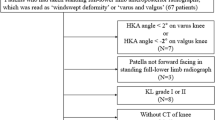Abstract
Purpose
This study investigated the relationship between femoral shaft bowing and the orientation of the surgical transepicondylar axis (TEA) in the coronal plane in varus knee osteoarthritis (OA).
Methods
A total of 82 knees scheduled to undergo total knee arthroplasty (TKA) for the treatment of varus knee OA were enrolled. The hip–knee-ankle angle (HKA) was measured preoperatively on anteroposterior whole-leg standing radiographs. The lateral angle between the TEA and the mechanical axis of the femur (MA-TEA) was measured in the coronal plane from preoperative computed tomography (CT) images. Femoral shaft bowing was measured on CT images. Pearson’s correlation coefficient was used to examine the correlation of the MA-TEA with the HKA and femoral shaft bowing.
Results
The MA-TEA correlated negatively with the HKA (r = − 0.321, P < 0.01) and positively with femoral shaft bowing (r = 0.415, P < 0.01).
Conclusions
The TEA changed to varus as femoral shaft bowing increased in patients with varus knee OA. This suggests that the TEA is not always the centre of the rotational axis of the femur after TKA. In addition, the TEA may not be useful as a consistent parameter in the coronal plane in patients with increasing femoral shaft bowing.
Level of evidence
III.







Similar content being viewed by others
Abbreviations
- TEA:
-
Transepicondylar axis
- TKA:
-
Total knee arthroplasty
- OA:
-
Osteoarthritis
- CT:
-
Computed tomography
- HKA:
-
Hip–knee-ankle angle
- ICCs:
-
Intraclass correlation coefficients
References
Akamatsu Y, Kobayashi H, Kusayama Y, Kumagai K, Saito T (2016) Femoral shaft bowing in the coronal and sagittal planes on reconstructed computed tomography in women with medial compartment knee osteoarthritis: a comparison with radiograph and its predictive factors. Arch Orthop Trauma Surg 136:1227–1232
Berger RA, Rubash HE, Seel MJ, Thompson WH, Crossett LS (1993) Determining the rotational alignment of the femoral component in total knee arthroplasty using the epicondylar axis. Clin Orthop Relat Res 286:40–47
Echhoff DG, Bach JM, Spitzer VM, Reinig KD, Bagur MM, Baldini TH, Rubinstein D, Humphries S (2003) Three-dimensional morphology and kinematics of the distal part of the femur viewed in virtual reality. J Bone Jt Surg Am 85:97–104
Kim JM, Hong SH, Kim JM, Lee BS, Kim DE, Kim KA, Bin SI (2015) Femoral shaft bowing in the coronal plane has more significant effect on the coronal alignment of TKA than proximal or distal variations of femoral shape. Knee Surg Sports Traumatol Arthrosc 23:1936–1942
Kobayashi H, Akamatsu Y, Kumagai K, Kusayama Y, Aratake M, Saito T (2015) Is the surgical epicondylar axis the center of rotation in the osteoarthritic knee? J Arthroplasty 30:479–483
Kobayashi H, Akamatsu Y, Kumagai K, Kusayama Y, Ishigatsubo R, Muramatsu S, Saito T (2014) The surgical epicondylar axis is a consistent reference of the distal femur in the coronal and axial planes. Knee Surg Sports Traumatol Arthrosc 22:2947–2953
Lasam MP, Lee KJ, Chang CB, Kang YG, Kim TK (2013) Femoral lateral bowing and varus condylar orientation are prevalent and affect axial alignment of TKA in Koreans. Clin Orthop Relat Res 471:1472–1483
Lustig S, Lavoie F, Selmi TA, Servien E, Neyret P (2008) Relationship between the surgical epicondylar axis and the articular surface of the distal femur: an anatomic study. Knee Surg Sports Traumatol Arthrosc 16:674–682
Matsumoto T, Hashimura M, Takayama K, Ishida K, Kawakami Y, Matsuzaki T, Nakano N, Matsushita T, Kuroda R, Kurosaka M (2015) A radiographic analysis of alignment of the lower extremities—initiation and progression of varus type knee osteoarthritis. Osteoarthr Cartil 23:217–223
Mochizuki T, Tanifuji O, Koga Y, Sato T, Kobayashi K, Nishino K, Watanabe S, Ariumi A, Fujii T, Yamagiwa H, Omori G, Endo N (2017) Sex differences in femoral deformity determined using three-dimensional assessment for osteoarthritic knees. Knee Surg Sports Traumatol Arthrosc 25:468–476
Mullaji AB, Marawar SV, Mittal V (2009) A comparison of coronal plane axial femoral relationships in Asian patients with varus osteoarthritic knees and healthy knees. J Arthroplasty 24:861–867
Palanisami D, Iyyampillai G, Shanmugam S, Natesan R (2016) Individualised distal femoral cut improves femoral component placement and limb alignment during total knee replacement in knees with moderate and severe varus deformity. Int Orthop 40:2049–2054
Yau WP, Chiu KY, Tang WM, Ng TP (2007) Coronal bowing of the femur and tibia in Chinese: its incidence and effects on total knee arthroplasty planning. J Orthop Surg (Hong Kong) 15:32–36
Zhang Y, Wang X, Shao Y, Xia Q (2018) The orientation of the surgical epicondylar axis varies in varus and non-varus knees in the coronal plane. Knee Surg Sports Traumatol Arthrosc 26:2580–2586
Funding
No funding was obtained for this study.
Author information
Authors and Affiliations
Contributions
SN: study design, data collection, interpreting the data and writing the paper. KK, HK: data collection. SY, TA, TO, MS, YI: interpretation. All authors read and approved the final manuscript.
Corresponding author
Ethics declarations
Conflict of interest
There are no conflicts of interest.
Ethics approval
Ethical approval for the study was obtained from the institutional review board of Yokohama City University Hospital (B190700006).
Consent to participate
Informed and written consent was obtained from all patients.
Additional information
Publisher's Note
Springer Nature remains neutral with regard to jurisdictional claims in published maps and institutional affiliations.
Rights and permissions
About this article
Cite this article
Nejima, S., Kumagai, K., Kobayashi, H. et al. Coronal shaft bowing of the femur affects varus inclination of the surgical transepicondylar axis in varus knee osteoarthritis. Knee Surg Sports Traumatol Arthrosc 29, 814–819 (2021). https://doi.org/10.1007/s00167-020-06025-1
Received:
Accepted:
Published:
Issue Date:
DOI: https://doi.org/10.1007/s00167-020-06025-1




